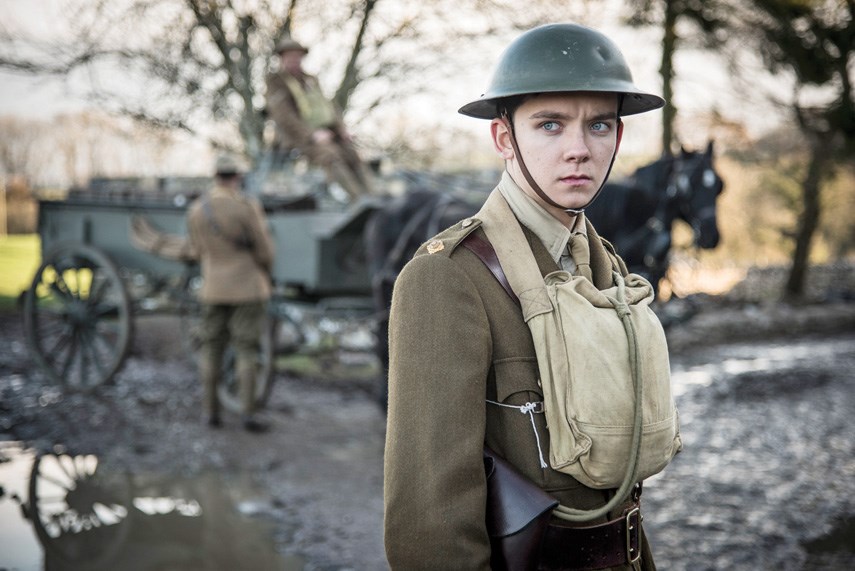Journey’s End. Directed by Saul Dibb. Starring Asa Butterfield, Sam Clafin and Paul Bettany. Rating: 8 (out of 10)
If you’re claustrophobic, best to leave Journey’s End off your viewing list, but all others will find treasure in these trenches.
The moving First World War drama rarely leaves the earthen living quarters – a virtual tomb – occupied by British officers in the trenches during the spring of 1918, the fourth year of trench warfare in German-occupied Northern France.
The film opens, fittingly, with men playing cards: this battle too is a game of chance. Each soldier must spend six days per month on the front line, and each man wonders if his turn will place him within bombing distance when the rumoured German offensive finally comes to break the stalemate.
Lieutenant James “Jimmy” Raleigh (Asa Butterfield) comes fresh from four weeks of basic training and asks his uncle, a general, to join the regiment captained by a school chum. The battle-hardened group is headed to the front, his uncle cautions, but after some prattle about failed crocuses he agrees.
With apologies for the smell – the French used bodies to shore up their trenches, apparently – Jimmy’s guide takes him through the labyrinthine trench and to the officer’s quarters. The first man he meets is Osborne (Paul Bettany) who is called “uncle” by the other men. He cautions Jimmy that his friend Stanhope is much altered since their school days. Also in the officers’ hole is Hibbert (Tom Sturridge), all but incoherent due to PTSD, the amiable Trotter (Stephen Graham) and cook Mason (Toby Jones), who knows just when to offer a cup of tea or the bottle of whisky.
Cpt. Stanhope (Sam Clafin) has seen years of warfare and lost many men. He can’t get through the day without a good amount of drink. Small things like tinned apricots instead of pineapples, or the absence of pepper in a meal, are likely to set him off. And he’s none too happy to see Jimmy: it reminds him of how changed he his, and how disappointed his love – Jimmy’s sister – would be if she saw him.
There isn’t much time to dwell on that, however, because the rumoured German offensive is confirmed to take place in two days’ time, on Stanhope’s watch. The men are to have no reinforcements. “Hold them off as long as you can,” orders his commanding officer, “Cheerio.”
“I’m glad it’s coming at last,” admits Osborne, “I’m sick of waiting.” Osborne is the heart of the film, and Bettany is perfectly suited to play him. It’s Osborne who can tame the monster in Stanhope, who puts him to bed, who takes his hand and strokes his hair the way he would with his children back home.
As if the imminent offensive wasn’t enough, C Company is assigned a mission that will surely send several of 10 enlisted men and two officers to their graves, a mission that is scheduled for daylight so that the commanders can discuss the results at an 8 o’clock dinner. Is it any wonder Stanhope is going batty?
The source material is R.C. Sherriff’s stage play, which starred a 21-year-old Laurence Olivier when it opened in London’s Apollo Theatre in 1928. Director James Whale (Frankenstein, Bride of Frankenstein, The Invisible Man) directed the first film version, in 1930.
Director Saul Dibb (Suite Francaise, The Duchess) actually ventures out more to the colourless mess of the trenches than in previous versions of the play, but the result is still confining. Dibb shot all interior scenes by candlelight and used handheld and Steadicam cameras to circle his actors: the close-ups only add to the sense of tight spaces and stale air. Usually the action in war movies places us directly in the trenches: it’s unusual to see movement to and from the front lines, just as it is to see life within the officers’ quarters, with their planked bunks, assigned cooks, and the incongruity of crystal in the dirt.
The film may be set exactly 100 years ago, but it feels all-too current. It’s a look at post-traumatic stress disorder decades before the diagnosis was conceived, at how men cope and crumble under the stress of warfare and waiting.
There’s no glory in this stiff-upper-lipped heroism and no score card: we see only vaguely one enemy soldier being shot, and we don’t turn a lens on British casualties until the end. The closing info gives a mutual body count: 700,000 during the three-month “Spring Offensive” with another one million before the end of the war. Ten million soldiers were killed during the First World War, plus some seven million civilians. It’s a statistic the militarists among us would do well to remember.



